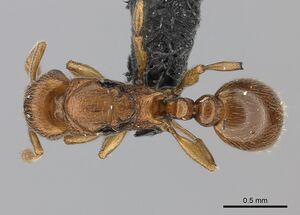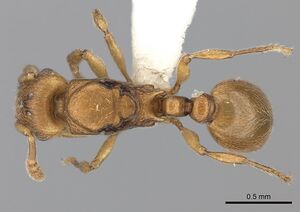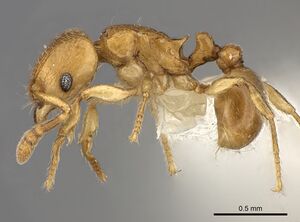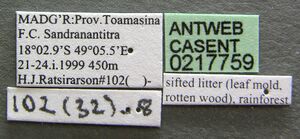Tetramorium rumo
| Tetramorium rumo | |
|---|---|

| |
| Scientific classification | |
| Kingdom: | Animalia |
| Phylum: | Arthropoda |
| Class: | Insecta |
| Order: | Hymenoptera |
| Family: | Formicidae |
| Subfamily: | Myrmicinae |
| Tribe: | Crematogastrini |
| Genus: | Tetramorium |
| Species group: | schaufussii |
| Species complex: | cognatum |
| Species: | T. rumo |
| Binomial name | |
| Tetramorium rumo Hita Garcia & Fisher, 2014 | |
Tetramorium rumo has been collected from leaf litter.
Identification
A member of the Tetramorium cognatum species complex of the Tetramorium schaufussii species group. Hita Garcia and Fisher (2014) - Tetramorium rumo can be well recognised within the T. cognatum species complex on the basis of the following character combination: very large eyes (OI 28–31); antennal scapes very short (SI 60–66); propodeal spines moderately long, elongate-triangular to spinose, and usually acute (PSLI 22–26); propodeal spines and lobes not strongly inclined towards each other; petiolar node thinly cuneiform and moderately squamiform, in profile around 2.3 to 2.7 times higher than long (LPeI 37–43), in dorsal view between 1.5 to 1.7 times wider than long (DPeI 156–171); mesosoma either with at least seven pairs of long, standing hairs on pronotum and mesonotum and propodeum sometimes with one pair anteriorly, or with just two pairs of long, standing hairs, one on anterior pronotum and one on anterior mesonotum.
Tetramorium rumo is very unlikely to be confused with the much larger species Tetramorium freya, Tetramorium gladius, Tetramorium myrmidon, Tetramorium proximum, and Tetramorium tenuinode. All the latter species, except T. freya, also have very well developed frontal carinae, which contrast with the reduced and very weak frontal carinae seen in T. rumo. Tetramorium freya has weaker frontal carinae than the other four species, but in contrast to T. rumo this species does not have any standing pilosity on the mesosomal dorsum. Furthermore, T. gladius has very small eyes (OI 19–20) compared to T. rumo, which has very large eyes (OI 28–31). The remaining four species of the T. cognatum complex are morphologically much closer to T. rumo than the five species mentioned above. However, Tetramorium camelliae is easily separable from T. rumo on the basis of the petiolar node shape, which is strongly squamiform and transverse in the former (LPeI 33–36; DPeI 228–238), contrasting with the highly nodiform to thinly cuneiform node of the latter (LPeI 37–43; DPeI 156–171). Tetramorium aspis and Tetramorium karthala both have longer antennal scapes (SI 68–74), shorter propodeal spines (PSLI 18–22), thicker and lower petiolar nodes in profile (LPeI 46–54), and less transverse nodes in dorsal view (DPeI 146–161) compared to T. rumo (SI 60–66; LPeI 37–43; DPeI 156–171). In addition, T. aspis has propodeal spines and lobes strongly inclined towards each other, an arrangement absent in T. rumo, and T. karthala is only found on the Comorian island of Grand Comore while T. rumo is distributed in Madagascar.
The last species of the T. cognatum complex, Tetramorium cognatum itself, is probably the closest relative of T. rumo within the complex, and without careful examination they could be confused in some cases. However, both differ clearly in propodeal spine length and petiolar node shape. Tetramorium rumo has relatively long and spinose propodeal spines (PSLI 22–26) which contrast with the much more reduced, short, and triangular teeth of T. cognatum (PSLI 12–16). Also, the thinly cuneiform petiolar node of T. rumo, which is 2.3 to 2.7 times higher than long (LPeI 37–43) and around 1.6 to 1.7 times wider than long (DPeI 156–171), discriminates it from T. cognatum, in which the node is 1.8 to 2.0 times higher than long (LPeI 49–55) and around 1.3 to 1.4 times wider than long (DPeI 129–142).
Nonetheless, the species most similar to T. rumo is likely Tetramorium rala from the T. schaufussi complex. Both species share a very similar habitus. Compared to all other species of the T. schaufussi species group, they are smaller in size, have relatively longer propodeal spines, a high nodiform to thinly cuneiform petiolar node, lack standing pilosity on the waist segments, and possess very bright body colouration. We have placed them in different species complexes on the basis of the presence (T. rala) or absence (T. rumo) of standing pilosity on the first gastral tergite, but otherwise these two species could be easily confused. However, despite the very strong similarities, substantial differences separate these species from each other. Most obviously, the petiolar node of T. rumo is thinner and stronger anteroposteriorly compressed, in profile around 2.3 to 2.7 times higher than long (LPeI 37–43), and in dorsal view between 1.5 to 1.7 times wider than long (DPeI 156–171). By contrast, T. rala has a node in profile is 2.0 to 2.2 times higher than long (LPeI 45–50), and in dorsal view around 1.3 to 1.5 times broader than long (DPeI 129–145). Also, T. rumo has larger eyes (OI 28–31) than T. rala (OI 26–28). In addition, their distribution ranges strongly overlap in central-eastern Madagascar and both species maintain their species identities without intermediate forms.
There is some noteworthy variation in mesosomal pilosity in T. rumo. The populations in the southeast from Andohahela to Vevembe and the type locality Manombo all have at least seven pairs of long, standing hairs on the pronotum and mesonotum and the propodeum sometimes has one pair anteriorly, whereas the populations further north from Perinet to Betampona all have just two pairs of long, standing hairs (one on the anterior pronotum and one on the anterior mesonotum). Nevertheless, since both population groups are widely separated geographically and other character divides them, we consider this a clear case of geographical variation.
Keys including this Species
Distribution
Mainly found in eastern Madagascar. However, the distribution range is somewhat unusual since T. rumo is found in the southeast from Andohahela to Ranomafana, and then much further north from Perinet to Betampona.
Latitudinal Distribution Pattern
Latitudinal Range: -17.88667° to -24.77639°.
| North Temperate |
North Subtropical |
Tropical | South Subtropical |
South Temperate |
- Source: AntMaps
Distribution based on Regional Taxon Lists
Malagasy Region: Madagascar (type locality).
Distribution based on AntMaps
Distribution based on AntWeb specimens
Check data from AntWeb
Countries Occupied
| Number of countries occupied by this species based on AntWiki Regional Taxon Lists. In general, fewer countries occupied indicates a narrower range, while more countries indicates a more widespread species. |

|
Estimated Abundance
| Relative abundance based on number of AntMaps records per species (this species within the purple bar). Fewer records (to the left) indicates a less abundant/encountered species while more records (to the right) indicates more abundant/encountered species. |

|
Habitat
Tetramorium rumo was mainly sampled in rainforests, rarely montane rainforests or littoral rainforests, at elevations ranging from 20 to 1250 m.
Biology
Castes
Images from AntWeb
 
| |
| Male (alate). Specimen code casent0070854. Photographer Estella Ortega, uploaded by California Academy of Sciences. | Owned by CAS, San Francisco, CA, USA. |
   
| |
| Holotype of Tetramorium rumo. Worker. Specimen code casent0073025. Photographer Michele Esposito, uploaded by California Academy of Sciences. | Owned by CAS, San Francisco, CA, USA. |
   
| |
| Queen (alate/dealate). Specimen code casent0108745. Photographer Will Ericson, uploaded by California Academy of Sciences. | Owned by CAS, San Francisco, CA, USA. |
   
| |
| Queen (alate/dealate). Specimen code casent0189102. Photographer Will Ericson, uploaded by California Academy of Sciences. | Owned by CAS, San Francisco, CA, USA. |
   
| |
| Worker. Specimen code casent0217759. Photographer Will Ericson, uploaded by California Academy of Sciences. | Owned by CAS, San Francisco, CA, USA. |
Nomenclature
The following information is derived from Barry Bolton's Online Catalogue of the Ants of the World.
- rumo. Tetramorium rumo Hita Garcia & Fisher, 2014: 97, figs. 22B, 23D, 24D, 27A, 38, 64 (w.) MADAGASCAR.
Unless otherwise noted the text for the remainder of this section is reported from the publication that includes the original description.
Description
Worker
(N=12). HL 0.47–0.55 (0.51); HW 0.43–0.49 (0.45); SL 0.26–0.32 (0.29); EL 0.12–0.14 (0.13); PH 0.21–0.24 (0.23); PW 0.34–0.39 (0.36); WL 0.56–0.67 (0.60); PSL 0.11–0.13 (0.12); PTL 0.07–0.09 (0.08); PTH 0.19–0.23 (0.21); PTW 0.12–0.15 (0.14); PPL 0.12–0.15 (0.13); PPH 0.17–0.20 (0.19); PPW 0.18–0.22 (0.20); CI 88–91 (90); SI 60–66 (64); OI 28–31 (29); DMI 58–62 (60); LMI 36–38 (38); PSLI 22–26 (23); PeNI 35–39 (38); LPeI 37–43 (41); DPeI 156–171 (162); PpNI 51–56 (54); LPpI 68–75 (72); DPpI 138–152 (146); PPI 141–152 (145).
Head much longer than wide (CI 88–91); in full-face view posterior head margin weakly concave. Anterior clypeal margin with distinct median impression. Frontal carinae very weakly developed, only feebly raised, usually ending shortly after posterior eye margin or merging with cephalic sculpture halfway between posterior eye margin and posterior head margin. Antennal scrobes very weak to absent, very shallow and without clear and distinct posterior and ventral margins. Antennal scapes very short, not reaching posterior head margin (SI 60–66). Eyes very large (OI 28–31). Mesosomal outline in profile flat to weakly convex, comparatively low and long (LMI 36–38), moderately marginate from lateral to dorsal mesosoma; promesonotal suture absent; metanotal groove very weak to absent. Propodeal spines moderately long, elongate-triangular to spinose, and usually acute (PSLI 22–26), propodeal lobes triangular and short, always much shorter than propodeal spines, in profile spines and lobes not strongly inclined towards each other. Petiolar node thinly cuneiform and moderately squamiform, in profile around 2.3 to 2.7 times higher than long (LPeI 37–43), anterior and posterior faces not parallel, anterodorsal margin usually situated higher and more strongly angled than posterodorsal margin, petiolar dorsum relatively flat to weakly convex and tapering backwards posteriorly; node in dorsal view between 1.5 to 1.7 times wider than long (DPeI 156–171), in dorsal view pronotum around 2.6 to 2.8 times wider than petiolar node (PeNI 35–39). Postpetiole in profile globular, between 1.3 to 1.5 times higher than long (LPpI 68–75); in dorsal view around 1.4 to 1.5 times wider than long (DPpI 138–152), pronotum around 1.8 to 1.9 times wider than postpetiole (PpNI 51–56). Postpetiole in profile appearing shorter and thicker than petiolar node, postpetiole in dorsal view around 1.4 to 1.5 times wider than petiolar node (PPI 141–152). Mandibles completely unsculptured, smooth, and shiny; clypeus weakly irregularly longitudinally rugulose, median rugula usually present but rarely fully developed, one or two mostly broken lateral rugulae present on each side; cephalic dorsum between frontal carinae longitudinally rugulose with eight to eleven fine rugulae, rugulae usually running from posterior clypeal margin to posterior head margin, often irregularly shaped, interrupted or with cross-meshes; scrobal area mostly unsculptured; lateral head mainly longitudinally rugulose to reticulate-rugulose, but larger areas often only weakly sculptured and appearing fairly smooth and shiny. Ground sculpture on head variable, ranging from weakly developed or absent to moderately punctate. Dorsum of mesosoma mostly longitudinally rugulose; lateral mesosoma mostly unsculptured with smaller, irregularly longitudinally rugulose or reticulate-rugulose areas. Ground sculpture on mesosoma very weak to absent. Forecoxae usually unsculptured, smooth, and shining. Both waist segments and gaster fully unsculptured, smooth, and shining. Dorsum of head with several pairs of long, fine, standing hairs; pilosity on dorsal mesosoma variable: southern populations with at least seven pairs on pronotum and mesonotum, propodeum sometimes with one pair anteriorly, and northern populations with only two pairs, one on anterior pronotum and one on anterior mesonotum; waist segments and first gastral tergite without any standing hairs; first gastral tergite with short, dense, appressed (rarely decumbent) pubescence. Anterior edges of antennal scapes and dorsal (outer) surfaces of hind tibiae with appressed to decumbent hairs. Body usually uniformly whitish yellow to light brown, very rarely darker.
Type Material
Holotype, pinned worker, MADAGASCAR, Fianarantsoa, Réserve Speciale Manombo 24.5 km 228° Farafangana, 23.01583°S, 47.719°E, 30 m, lowland rainforest, collection code BLF13963, 20.IV.2006 (B.L. Fisher et al.) (California Academy of Sciences: CASENT0073025). Paratypes, seven pinned workers with same data as holotype (The Natural History Museum: CASENT0071823; CAS: CASENT0071827; CASENT0072469; CASENT0073028; CASENT0073033; CASENT0073038; CASENT0073039).
Etymology
The new species is named after the fictional character “Rumo” from Walter Moers’ fantasy novel “Rumo and His Miraculous Adventures”. Tetramorium rumo is a very bright species, almost white, with distinct propodeal spines reminiscent of “Rumo”, who is a white wolperting with short but acute horns. The species epithet is an arbitrary combination of letter, thus invariable.
References
References based on Global Ant Biodiversity Informatics
- Blaimer B. B., S. G. Brady, T. R. Schultz, and B. L. Fisher. 2015. Fucntional and phylogenetic approaches reveal the evolution of diversity in a hyper diverse biota. Ecography 38: 001-012.
- Hita Garcia F, and B. L. Fisher. 2014. The hyper-diverse ant genus Tetramorium Mayr (Hymenoptera, Formicidae) in the Malagasy region - taxonomic revision of the T. naganum, T. plesiarum, T. schaufussii, and T. severini species groups. ZooKeys 413: 1-170.

